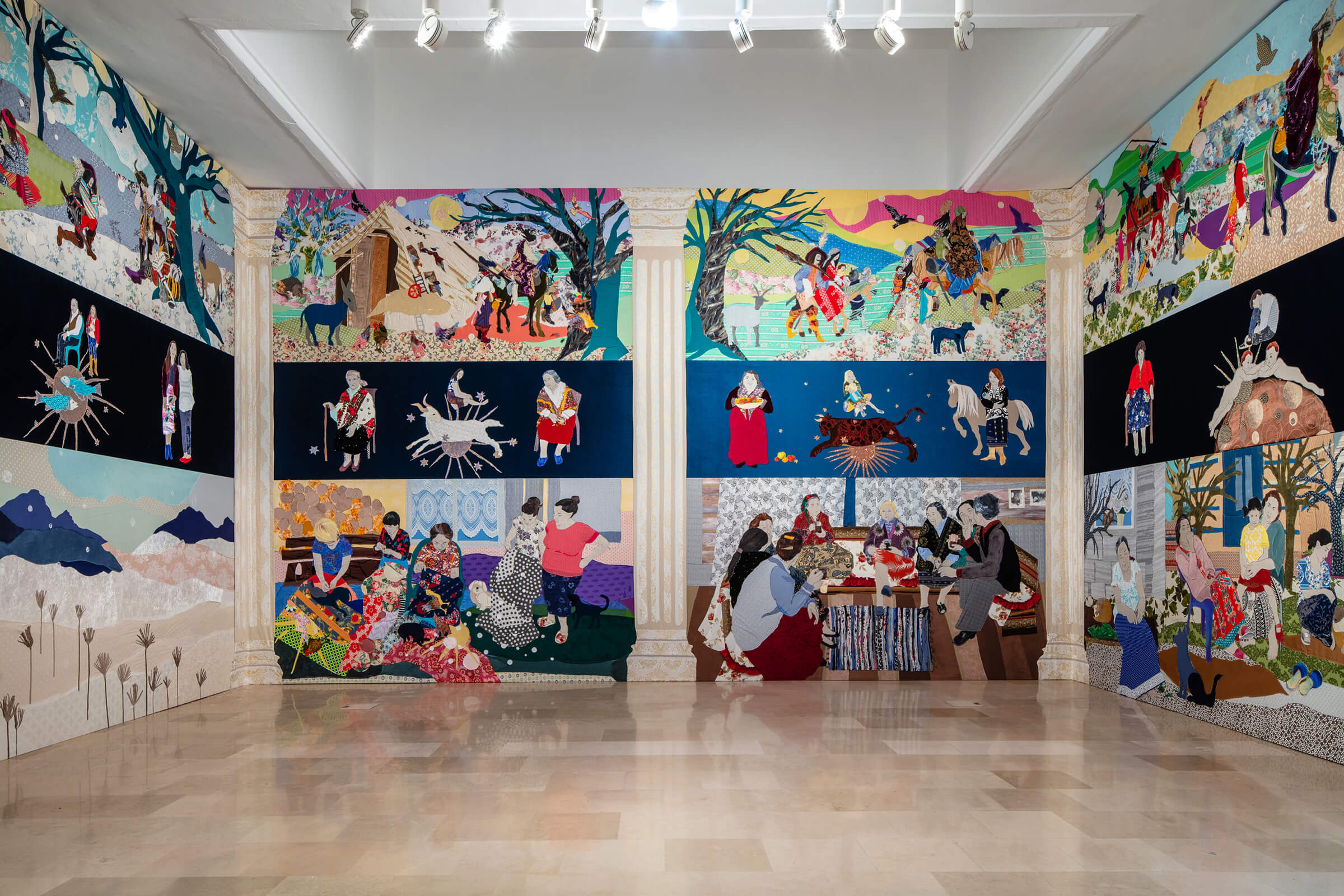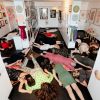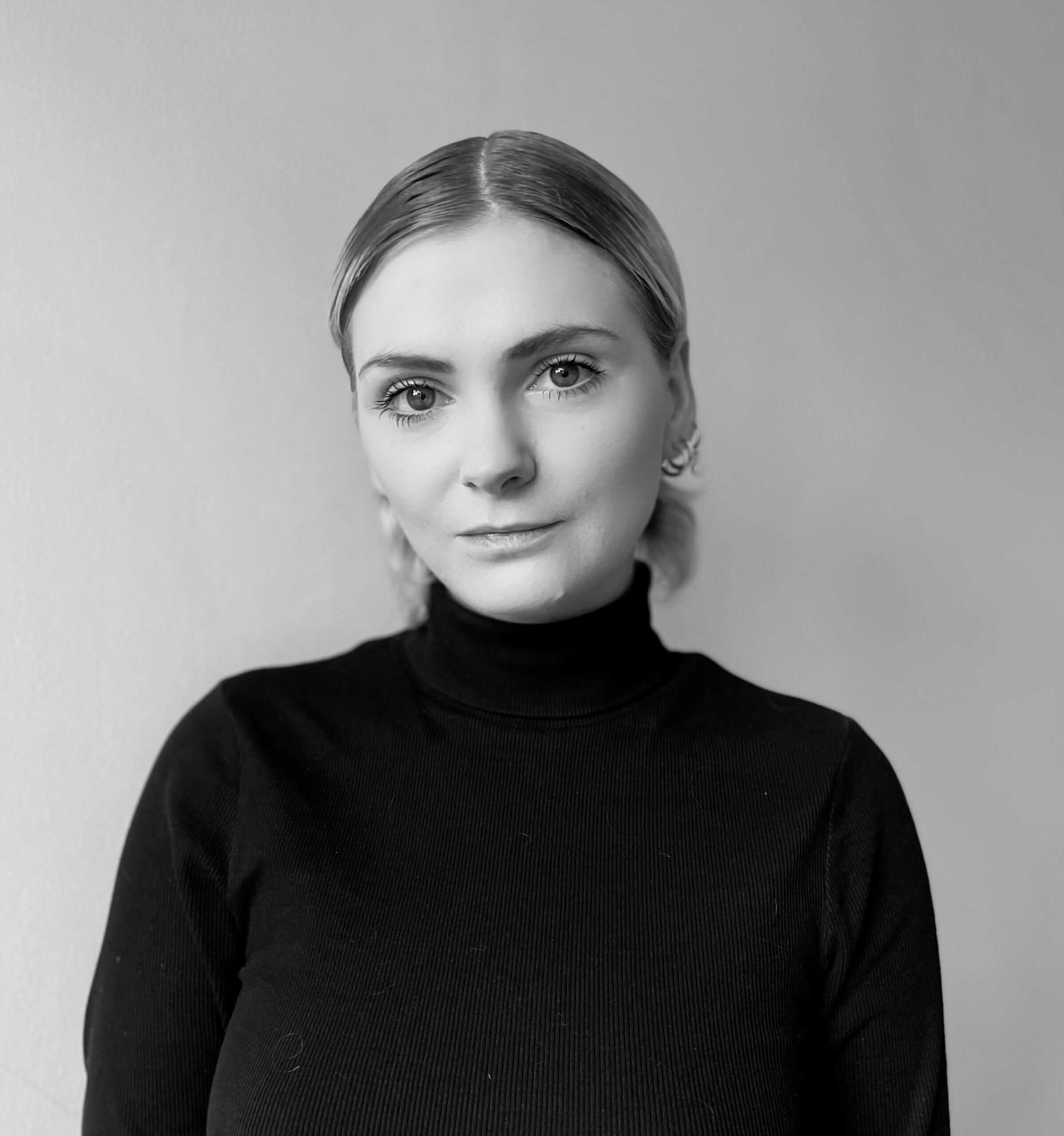La Biennale di Venezia
59th International Art Exhibition
The Milk of Dreams
Venice (Giardini and Arsenale), 23 April – 27 November 2022
After a year’s delay, the Venice Biennale has opened its doors to the public and will run throughout the summer till November 2022. The central exhibition, The Milk of Dreams, includes 213 artists from 58 countries, meanwhile there are 80 National Participations in the historic spaces at the Giardini, the Arsenale and in the city centre of Venice.
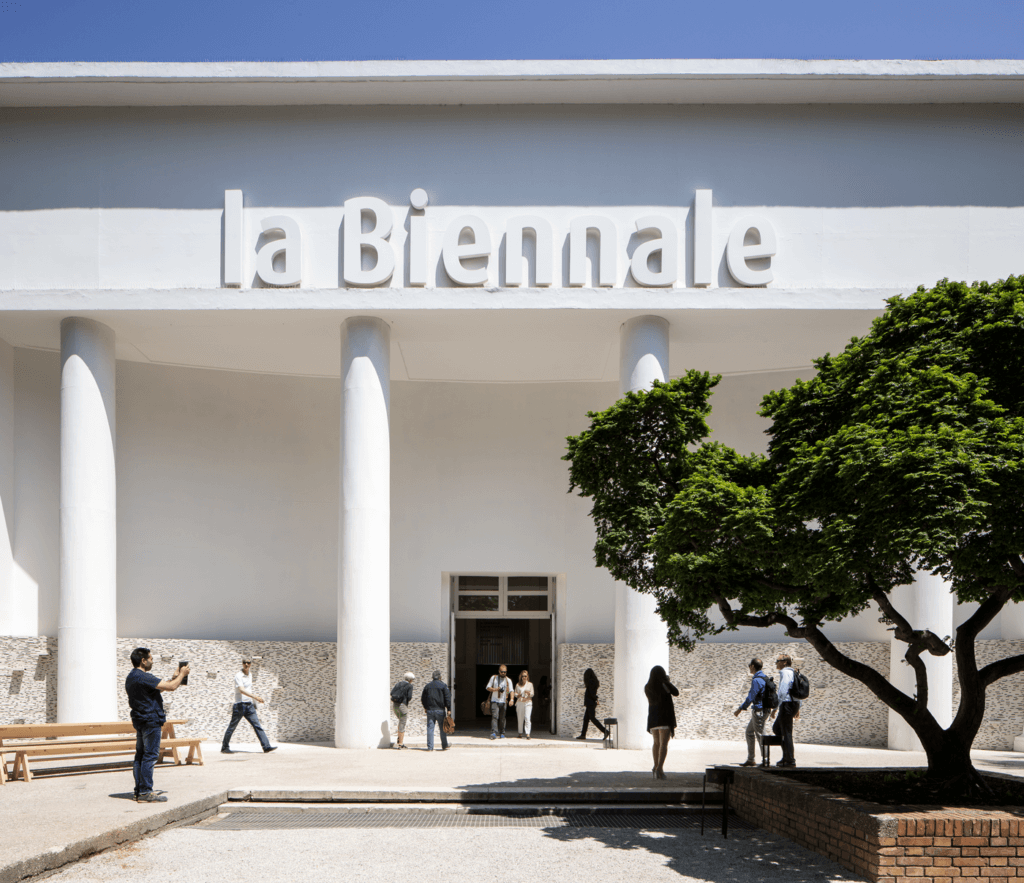
A truly sprawling festival of art, the Venice Biennale spans much further than the confines of the Giardini and Arsenale. The entire city is alive with collateral exhibitions, coinciding exhibitions, outdoor installations, special events and much more. With so much to see, it’s hard to be sure you’re not missing the highlights. With this in mind, here’s a selection of the Pavilions not to miss to get you started.

1: POLAND | Re-enchanting the World by Małgorzata Mirga-Tas | Curated by Wojciech Szymański and Joanna Warsza | Giardini
Malgorzata Migra Tas’s stunning textile installation transforms the Polish Pavilion into an enchanting realm of wonder. The exhibition marks the first time a Roma artist has presented a national pavilion in the 120-year history of the Venice Biennale, and in doing so illuminates and begins to correct a history of erasure and cultural erosion on European soil.
The truly exceptional piece covers both the frontage and the interior of the Polish Pavilion with large scale fabric sewn tapestries inspired by the famous cycle of frescos in the Renaissance Palazzo Schofanoia located in Ferrara, Italy. The villa’s name means ‘escape from boredom’ a notion at large in the intricate and detail orientated pieces by Migra-Tas, that immediately draw the viewer into a mesmerising world of the artist’s creation.
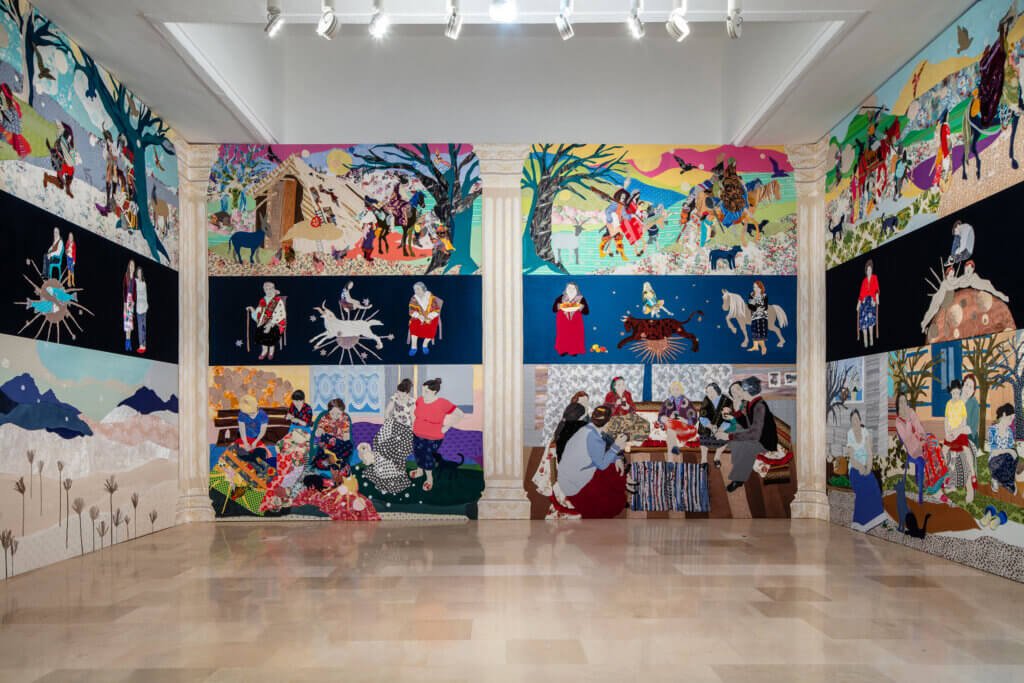
Each of the 12 tapestries is divided into vertical sections which explore separate but interlinked narratives of Roma history. The upper-most segment reframes problematic stereotypes and historic derogatory depictions of Roma people by re-telling the stories of their peregrinations across Europe.
It revisits Romani past with care and understanding, inscribing these narratives with beauty and unpicking layers of persecution and rejection. The middle section writes a Herstory – an archive of Roma history from a female perspective accompanied by astrological imagery and tarot figures leading the women depicted to appear like symbolic goddesses, guardians of fate and prophetesses. Finally, the lowest section depicts contemporary everyday experiences in the artists locality through the lives of the women with whom she surrounds herself.
At once a watershed moment of representation, a poignant retelling of a largely ignored transnational history, and a visual masterpiece – the Polish pavilion is an absolute triumph, and certainly not one to be missed
2: UNITED STATES OF AMERICA | Sovereignty by Simone Leigh| Curated by Eva Respini | Giardini
The first black woman to represent the USA at the Biennale, Simone Leigh presents a monumental and affecting new body of work. The pieces on show continue her practice of exploring expanded notions of black female subjectivity through esoteric sculptural combinations of the female body and architectural forms. Her works are often rendered in materials and through processes affiliated with the black diaspora. Through video, performance, sculpture, and more she offers imaginary narratives to fill the lacunas of black history. Her work proposes new hybridities, while also drawing attention to colonial histories of oppression and creating space for celebrating the black female experience.
Both inside and outside the Pavillion, Leigh’s series of new bronzes and ceramics stand firmly, with a domineering and yet enticing presence. They are affirmative and commanding, meditatively presiding over the guests at the Giardini. The title, Sovereignty speaks to self-determination and by extension self-governance, autonomy and independence. It speaks of freedom.
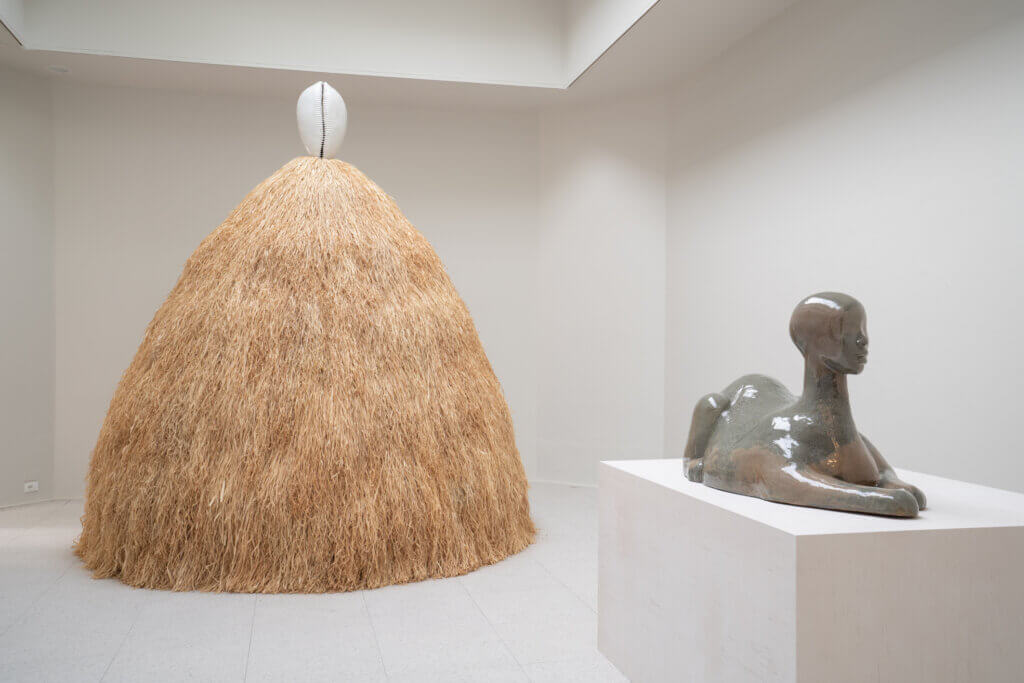
The sculptures include a poetic black pool with a solitary woman, frozen in time as she leans to collect water; it brings forth notions of environmental connectedness, familial care, labour and collectivity. Other works interrogate the extraction of certain objects and images from the African diaspora as souvenirs in service of colonial narratives, including the vases decorated with orate Cowery shells. These shells have a plethora of meaningful resonances, having historically been prized charms associated with fecundity, sexual pleasure and good luck in certain parts of Africa, and being introduced to the West through use as currency in the slave trade.
The presentation subtly weaves together an expansive collection of black feminist thought, a decided and considered use of materials and memorably arresting formal aesthetics to create a space of empowerment and a sense of refusal – to be controlled, tamed, oppressed, obliged to justify ones own worth.
3: SERBIA | Walking with Water by Vladimir Nikolić |Curated by Biljana Ćirić | Giardini
At once welcoming, calming and awakening Vladimir Nikolić’s work for the Serbian pavilion presents the viewer with new horizons. It illuminates our connection to and over reliance on modern technology while also enacting a primitive return to water.
The work is deceptively simple – two large-scale screens, one showing a lapping sea and the other a birds-eye view of a single man swimming lengths. Yet, a myriad of meanings can be found. Largely it is a reminder of the body’s connection to water, and with it a sense of being bound to nature.

The larger work, A Document metaphorically submerges the viewer in the lapping sea through its boundlessness and scale. 800m meanwhile is decidedly human, a man swims lengths in a man-made pool in all its chlorinated glory. Having been filmed with a drone from above, the viewpoint is technological and humancentric, akin to a google maps image. The vertical orientation of the screen is reminiscent of the act of mobile phone scrolling, a small hand gesture monumentalised by a whole body. It invites us to question the extent to which our existences are technologically mediated.
Despite the works reliance on technology for its fabrication – the screen, the camera and the drone – there is a rejection of western technological modalities at play. Our notion of time is reframed, the lapping sea and the repeated lengths become the tempo by which the work is experienced. The calming rhythm silences the viewer, and we find serenity in the quiet.
Underlying the project are urgent ecological concerns and references to scholars such as Donna Haraway who ask us to seek interconnectedness, entanglement and to ‘become with’. By this, she means finding routes for symbiosis and collaboration with nature instead of destruction and utilisation.
The pavilion is bold in its sparsity, so much being said by two films shown on two screens. It’s emotionally and physically impactful, bringing peace and a welcome retreat. It is also thought-provoking and challenging, asking the viewer to become metaphorically submerged in the water and all that it comes to signify.
4: BELGIUM | The Nature of the Game by Francis Alÿs | Curated by Hilde Teerlinck | Giardini
Artist behind the Belgium Pavilion, Francis Alÿs states, “I think that we, as adults, should be faithful to the children we were.” This appreciation for the necessity and beauty of childhood is brought to the fore in his presentation. It features videos and paintings of children playing freely all over the world, there is footage from Afghanistan, Belgium, Democratic Republic of the Congo, Hong Kong, Mexico and Switzerland filmed from 1999 onwards. In each a universal experience emerges, of childish competitiveness, joy and the freedom of innocence.
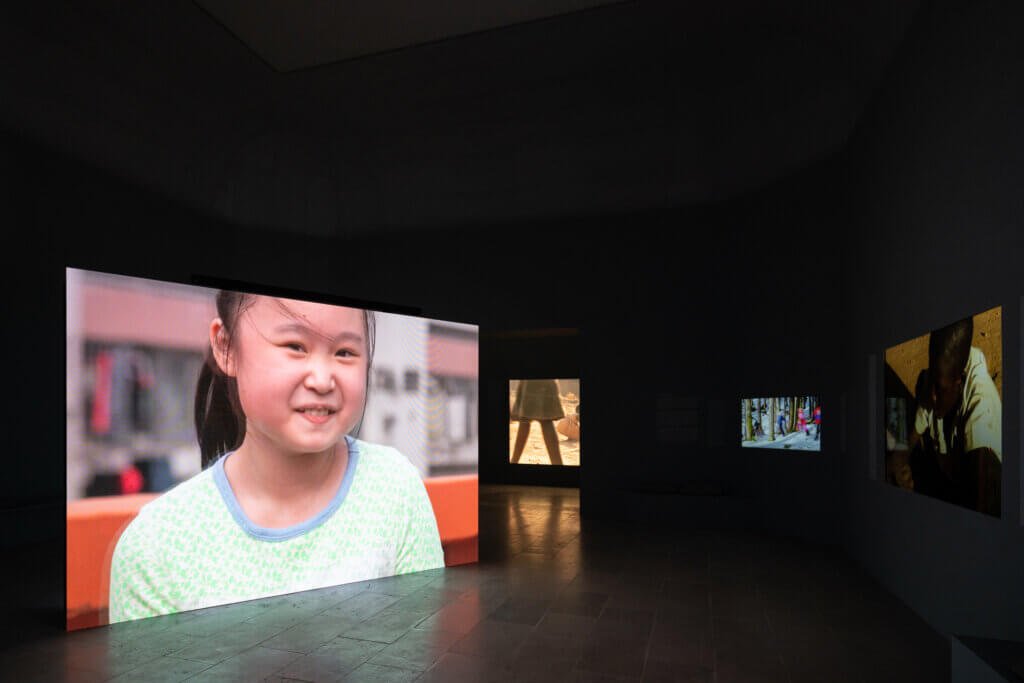
In all scenarios, including locations of war and poverty, children continue to play. Throughout, there is a certain hopefulness in the children’s resilience and insistence on finding joy in any circumstance. Some games re-appear across territories suggesting there is something intrinsic about the nature of playing, while others show specificity to place and subsequently offer a real insight into a location’s socio-cultural codes. At times the games even appear absurd, a sense of lawlessness pervades.
In part, the work draws inspiration from a 17th century painting by Breughel, Children’s Games, a picture which Alÿs has acknowledged left a big impression when he first saw it as a child. This painting has also been linked to a Flemish poem by an anonymous writer from 1530, in which mankind as a whole is compared to children who are entirely absorbed in their foolish games and concerns. However, for me, rather than play as foolishness, I am taken with the work as a reminder of collectivity, collaboration and human interaction. It underlines the ways in which we learn to relate to our peers as children and reasserts the primacy of being present with others.
5: UGANDA | RADIANCE: They dream In Time by Acaye Kerunen and Collin Sekajugo | Curated by Shaheen Merali | Palazzo Palumbo Fossati, San Marco 259
Uganda’s first ever Pavilion brings together the work of two artists who use very different lexicons to speak of the spaces between dichotomies. Issues emerge surrounding heritage versus modernisation, high art versus craft, representation verses erasure, and urbanisation versus ecological preservation.
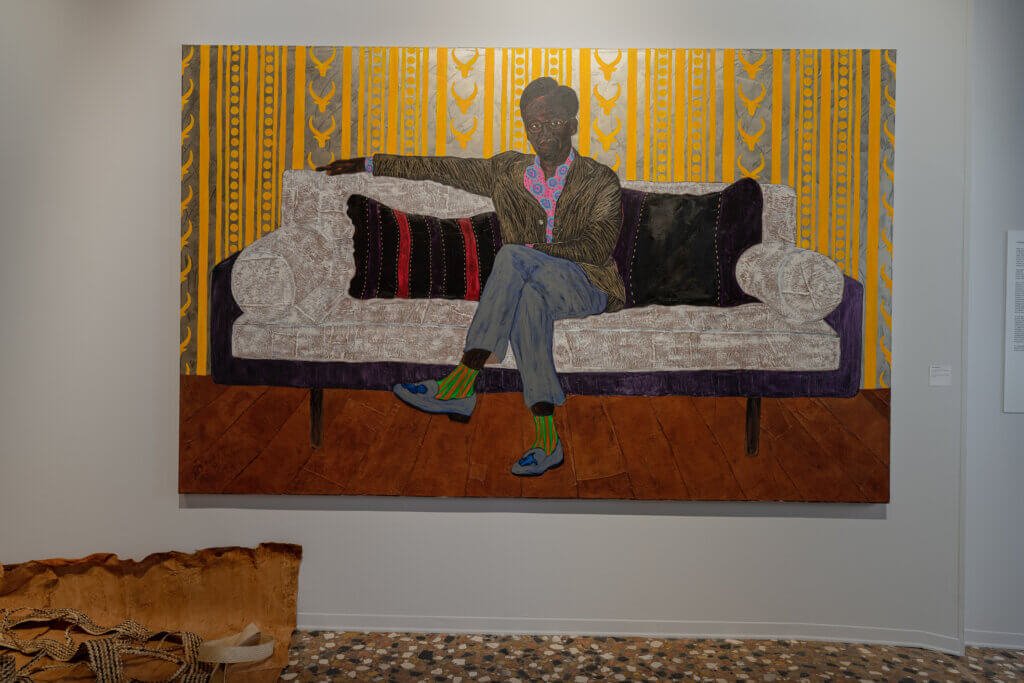
Acaye Kerunen’s intricate textile installations champion the important work of Uganda’s local craftswomen. The vast and impressive pieces are all handmade, created through processes of stitching, appending, knotting and weaving with natural fibre. This manual practice comes from a form of inherited knowledge, employing tasks she watched her mother complete growing up in Kampala to artistic ends. Her work repositions traditional craftwork, opening dialogues surrounding the creative modalities given primacy by the western art canon.
Much of Acaye’s work involves collaborations with women, some in transition from domestic violence, poverty or internal displacement. A feminism rhetoric emerges promoting African women and their creativeness, while also questioning western liberal feminism and its usefulness in the context of the lived realities and needs of African women. In many ways, Acaye frames a new form of female empowerment that puts environmental consciousness, collaboration and creativity at its centre. Collin Sekajugo’s striking portrait paintings line the walls of the space, bringing a buzzing energy with bright colour and dense pattern.
Each painting is usually populated by one figure, often appearing relaxed, almost caught off guard and set against a background of intense pattern reminiscent of African fabrics. Through these works, he seeks to examine the intrinsic biases of portrait imagery and reject the limits of who is entitled representation and why. Much of his process is predicated on remaking stock and found imagery, a method through which he rejects the prevalence of the western self and brings new embodiments into the frame.
An important historic moment for Uganda, their pavilion is joyful and distinctive. It brings together such desperate artworks with ease, while inviting discussion of a mirid of timely and important tensions at play in global society.
La Biennale di Venezia 59th International Art Exhibition The Milk of Dreams opens on the 23rd of April until 27th of November 2022
©2022 La Biennale di Venezia
Art writer, curator and public relations specialist, focussed on platforming emerging talent across the visual culture sector. When not walking my dog in rainy East London parks, I can be found on my sofa writing articles for FAD magazine, Bricks Magazine, Art Plugged and Off the Block Magazine. Find me on Instagram @bellabonner


